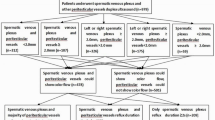Abstract
According to the haemodynamic classification of varicocele type I is caused by renospermatic reflux due to a proximal nutcracker phenomenon or to valvular insufficiency of the left internal spermatic vein. Type II is due to ileospermatic reflux and type III may be characterized by a combination of I and II refluxes. Although this classification proposed by Coolsaet is precious for decision making, it is seldom used in clinical practice being based on a complex angiographic evaluation which is invasive and exposes the patient (often a teenager or with infertility disturbances) to excessive radiations. The aim of the present study was to work up an original ultrasonographic test for preoperative haemodynamic evaluation of varicocele in order to indicate the most appropriate microsurgical treatment. Sixty-three patients underwent a preoperative clinico-echographic dynamic test which allowed to classify 76.9% of the cases as haemodynamic type I, 10.7% as type II and 12.3% as type III. Microsurgical shunts were performed in all cases and evaluation of recurrences was accurately carried out with ultrasonographic measurement of residual varicosities. In 6% of the cases varicosities were consistently reduced in size and in 94% absence of varicosities was demonstrated. Varicocele increased in size or was unchanged in none of the cases. In conclusion the test hereby described was shown to be simple and easily reproducible. It allowed a haemodynamic and objective classification of varicocele offering a unique opportunity for tailoring to the individual patient the most appropriate treatment. Furthermore, ultrasonographic postoperative follow-up is the most reliable and objective method to control the “true” incidence of post-varicocelectomy recurrences.
Similar content being viewed by others
References
Marmar, J. L., De Benedictis, T. J., Praiss, D.: The management of varicoceles by microdissection of the spermatic cord at the external inguinal ring.Fertil. Steril., 43, 583 (1985).
Sigmund, G., Bähren, W., Gall, H., Lenz, W., Thon, W.: Idiopathic varicoceles: Feasibility of percutaneous sclerotherapy.Radiology, 164,161 (1987).
Coolsaet, B. L. R. A.: The varicocele syndrome: Venography determining the optimal level for surgical management.J. Urol., 124, 833 (1980).
Mali, W. P. Th. M., Oei, H. Y., Arndt, J. W., Kremer, J., Coolsaet, B. L. R. A., Schuur, K.: Hemodynamics of the varicocele. Part II. Correlation among the results of renocaval pressure measurements, varicocele scintigraphy and phlebography.J. Urol., 135, 489 (1986).
Bigot, J. M., Barret, F., Henelon, C.: Phlebography of the right spermatic vein in varicoceles. In: Jecht, E. W., Zeiler, E. (eds): Varicocele and Male Infertility. Springer-Verlag, Berlin 1982, p. 59.
Sigmund, G., Gall, H., Bähren, W., Wetterauer, H.: Hemodynamics of varicocele: Venous shunting in grade II and III varicoceles.Ann. Radiol., 32, 24 (1988).
Hunger, D. W., Rildsoe, M. C., Amelatz, K.: Aid for safer sclerotherapy of the internal spermatic vein.Radiology, 173, 282 (1989).
WHO: Comparison among different methods for the diagnosis of varicocele.Fertil. Steril., 43, 575 (1985).
Flati, G., Porowska, B., Flati, D., Carboni, M.: Microsurgical treatment of varicocele. Selecting most appropriate shunt.Urology, XXXV (2), 121 (1990).
McClure, D. R., Hricak, H.: Scrotal ultrasound in the infertile man: Detection of subclinical unilateral and bilateral varicocele.J. Urol., 135, 711 (1986).
Rifkin, M. D., Foy, P., Kurtz, P. M., Pasto, M. E., Goldberg, B. B.: The role of diagnostic ultrasonography in varicocele evaluation.J. Ultrasound Med., 2, 271 (1983).
Wolverson, M. K., Houttuin, E., Heiberg, E., Sundaram, M., Gregory, J.: High resolution real time sonography of scrotal varicocele.Am. J. Roentgenol., 141, 775 (1983).
Zuckerman, A., Mitchel, S., Venbruk, A., Trerotola, S., Savader, S., Lund, G., White, R., Osterman, F.: Percutaneous varicocele occlusion: Long-term follow-up.JVIR, 5, 315 (1994).
Gonzalez, R., Reddy, P., Kaye, K. W., Narayan, P.: Comparison of doppler examination and retrograde spermatic venography in the diagnosis of varicocele.Fertil. Steril., 40, 96 (1983).
Author information
Authors and Affiliations
Rights and permissions
About this article
Cite this article
Flati, G., Flati, D., La Pinta, M. et al. A simple ultrasonographic test for preoperative haemodynamic evaluation of varicocele. International Urology and Nephrology 30, 59–67 (1998). https://doi.org/10.1007/BF02550280
Accepted:
Issue Date:
DOI: https://doi.org/10.1007/BF02550280




